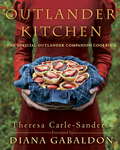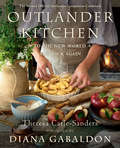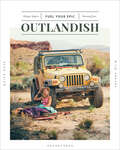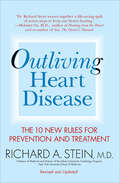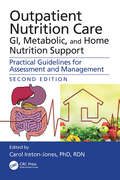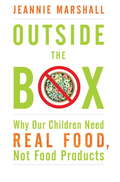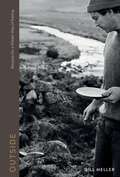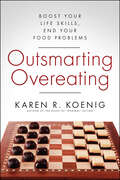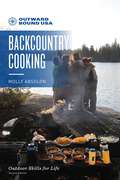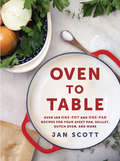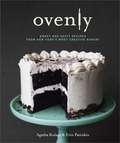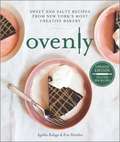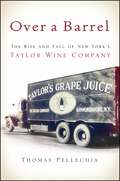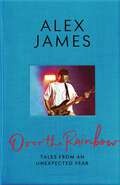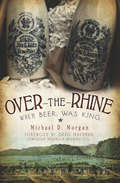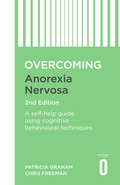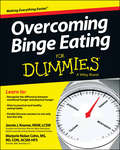- Table View
- List View
Outlander Kitchen: The Official Outlander Companion Cookbook
by Theresa Carle-SandersTake a bite out of Diana Gabaldon's New York Times bestselling Outlander novels, the inspiration for the hit Starz series, with this immersive official cookbook from OutlanderKitchen.com founder Theresa Carle-Sanders! Claire Beauchamp Randall's incredible journey from postwar Britain to eighteenth-century Scotland and France is a feast for all five senses, and taste is no exception. From Claire's first lonely bowl of porridge at Castle Leoch to the decadent roast beef served after her hasty wedding to Highland warrior Jamie Fraser, from gypsy stew and jam tarts to fried chicken and buttermilk drop biscuits, there are enough mouth-watering meals along the way to whet the appetite of even the most demanding palate. Now professional chef and founder of OutlanderKitchen.com Theresa Carle-Sanders offers up this extraordinary cuisine for your table. Featuring more than one hundred recipes, Outlander Kitchen retells Claire and Jamie's incredible story through the flavors of the Scottish Highlands, the French Revolution, and beyond. Following the high standards for prodigious research and boundless creativity set by Diana Gabaldon herself, Carle-Sanders draws on the events and characters of the novels to deliver delicious and inventive dishes that highlight local ingredients and traditional cooking techniques. Yet amateur chefs need not fear: These doable, delectable recipes have been updated for today's modern kitchens. Here are just a few of the dishes that will keep the world of Outlander on your mind morning, noon, and nicht: * Breakfast: Yeasted Buckwheat Pancakes; A Coddled Egg for Duncan; Bacon, Asparagus, and Wild Mushroom Omelette * Appetizers: Cheese Savories; Rolls with Pigeons and Truffles; Beer-Battered Corn Fritters * Soups & Stocks: Cock-a-Leekie Soup; Murphy's Beef Broth; Drunken Mock-Turtle Soup * Mains: Peppery Oyster Stew; Slow-Cooked Chicken Fricassee; Conspirators' Cassoulet * Sides: Auld Ian's Buttered Leeks; Matchstick Cold-Oil Fries; Honey-Roasted Butternut Squash * Bread & Baking: Pumpkin Seed and Herb Oatcakes; Fiona's Cinnamon Scones; Jocasta's Auld Country Bannocks * Sweets & Desserts: Black Jack Randall's Dark Chocolate Lavender Fudge; Warm Almond Pastry with Father Anselm; Banoffee Trifle at River Run With full-color photographs and plenty of extras--including cocktails, condiments, and preserves--Outlander Kitchen is an entertainment experience to savor, a wide-ranging culinary crash course, and a time machine all rolled into one. Forget bon appétit. As the Scots say, ith do leòr!From the Hardcover edition.
Outlander Kitchen: The Official Outlander Companion Cookbook
by Theresa Carle-SandersTake a bite out of Diana Gabaldon's New York Times bestselling Outlander novels, the inspiration for the hit Starz series, with this immersive official cookbook from OutlanderKitchen.com founder Theresa Carle-Sanders! Claire Beauchamp Randall's incredible journey from postwar Britain to eighteenth-century Scotland and France is a feast for all five senses, and taste is no exception. From Claire's first lonely bowl of porridge at Castle Leoch to the decadent roast beef served after her hasty wedding to Highland warrior Jamie Fraser, from gypsy stew and jam tarts to fried chicken and buttermilk drop biscuits, there are enough mouth-watering meals along the way to whet the appetite of even the most demanding palate. Now professional chef and founder of OutlanderKitchen.com Theresa Carle-Sanders offers up this extraordinary cuisine for your table. Featuring more than one hundred recipes, Outlander Kitchen retells Claire and Jamie's incredible story through the flavors of the Scottish Highlands, the French Revolution, and beyond. Following the high standards for prodigious research and boundless creativity set by Diana Gabaldon herself, Carle-Sanders draws on the events and characters of the novels to deliver delicious and inventive dishes that highlight local ingredients and traditional cooking techniques. Yet amateur chefs need not fear: These doable, delectable recipes have been updated for today's modern kitchens. Here are just a few of the dishes that will keep the world of Outlander on your mind morning, noon, and nicht: * Breakfast: Yeasted Buckwheat Pancakes; A Coddled Egg for Duncan; Bacon, Asparagus, and Wild Mushroom Omelette * Appetizers: Cheese Savories; Rolls with Pigeons and Truffles; Beer-Battered Corn Fritters * Soups & Stocks: Cock-a-Leekie Soup; Murphy's Beef Broth; Drunken Mock-Turtle Soup * Mains: Peppery Oyster Stew; Slow-Cooked Chicken Fricassee; Conspirators' Cassoulet * Sides: Auld Ian's Buttered Leeks; Matchstick Cold-Oil Fries; Honey-Roasted Butternut Squash * Bread & Baking: Pumpkin Seed and Herb Oatcakes; Fiona's Cinnamon Scones; Jocasta's Auld Country Bannocks * Sweets & Desserts: Black Jack Randall's Dark Chocolate Lavender Fudge; Warm Almond Pastry with Father Anselm; Banoffee Trifle at River Run With full-color photographs and plenty of extras--including cocktails, condiments, and preserves--Outlander Kitchen is an entertainment experience to savor, a wide-ranging culinary crash course, and a time machine all rolled into one. Forget bon appétit. As the Scots say, ith do leòr!From the Hardcover edition.
Outlander Kitchen: The Official Outlander Companion Cookbook
by Theresa Carle-SandersTake a bite out of Diana Gabaldon’s New York Times bestselling Outlander novels, the inspiration for the hit Starz series, with this immersive official cookbook from OutlanderKitchen.com founder Theresa Carle-Sanders! Claire Beauchamp Randall’s incredible journey from postwar Britain to eighteenth-century Scotland and France is a feast for all five senses, and taste is no exception. From Claire’s first lonely bowl of porridge at Castle Leoch to the decadent roast beef served after her hasty wedding to Highland warrior Jamie Fraser, from gypsy stew and jam tarts to fried chicken and buttermilk drop biscuits, there are enough mouth-watering meals along the way to whet the appetite of even the most demanding palate. Now professional chef and founder of OutlanderKitchen.com Theresa Carle-Sanders offers up this extraordinary cuisine for your table. Featuring more than one hundred recipes, Outlander Kitchen retells Claire and Jamie’s incredible story through the flavors of the Scottish Highlands, the French Revolution, and beyond. Following the high standards for prodigious research and boundless creativity set by Diana Gabaldon herself, Carle-Sanders draws on the events and characters of the novels to deliver delicious and inventive dishes that highlight local ingredients and traditional cooking techniques. Yet amateur chefs need not fear: These doable, delectable recipes have been updated for today’s modern kitchens. Here are just a few of the dishes that will keep the world of Outlander on your mind morning, noon, and nicht: • Breakfast: Yeasted Buckwheat Pancakes; A Coddled Egg for Duncan; Bacon, Asparagus, and Wild Mushroom Omelette • Appetizers: Cheese Savories; Rolls with Pigeons and Truffles; Beer-Battered Corn Fritters • Soups & Stocks: Cock-a-Leekie Soup; Murphy’s Beef Broth; Drunken Mock-Turtle Soup • Mains: Peppery Oyster Stew; Slow-Cooked Chicken Fricassee; Conspirators’ Cassoulet • Sides: Auld Ian’s Buttered Leeks; Matchstick Cold-Oil Fries; Honey-Roasted Butternut Squash • Bread & Baking: Pumpkin Seed and Herb Oatcakes; Fiona’s Cinnamon Scones; Jocasta’s Auld Country Bannocks • Sweets & Desserts: Black Jack Randall’s Dark Chocolate Lavender Fudge; Warm Almond Pastry with Father Anselm; Banoffee Trifle at River Run With full-color photographs and plenty of extras—including cocktails, condiments, and preserves—Outlander Kitchen is an entertainment experience to savor, a wide-ranging culinary crash course, and a time machine all rolled into one. Forget bon appétit. As the Scots say, ith do leòr!From the Hardcover edition.
Outlander Kitchen: The Second Official Outlander Companion Cookbook
by Theresa Carle-SandersSink your teeth into over 100 new easy-to-prepare recipes inspired by Diana Gabaldon&’s beloved Outlander and Lord John Grey series, as well as the hit Starz original show—in the second official cookbook from Outlander Kitchen founder Theresa Carle-Sanders!&“If you thought Scottish cuisine was all porridge and haggis washed down with a good swally of whiskey, Outlander Kitchen&’s here to prove you wrong.&”—Entertainment WeeklyWith the discovery of a New World comes an explosion of culinary possibilities. The later novels in Diana Gabaldon&’s Outlander series and the Lord John Grey series have Jamie, Claire, Lord John, and friends embark on their revolutionary adventures across the Atlantic and back again—and with their voyages come hundreds of new mouthwatering flavors to entice the taste buds of even the most discerning palates.Professional chef and founder of Outlander Kitchen, Theresa Carle-Sanders returns with another hallmark cookbook—one that dexterously adapts traditional recipes for hungry, modern appetites. Interpreted with a spirit of generous humor and joyous adventure, the recipes herein are a mixture of authentic old-worldreceipts from Scottish settlers, new-world adaptations inspired by the cuisine of indigenous peoples, and humorously delicious character-inspired dishes—all created to satisfy your hunger and insatiable craving for everything Outlander, and with the modern kitchen in mind:• Breakfast: Mrs. Figg&’s Flapjacks; Simon Fraser&’s Grits with Honey• Soups: Leek and Potato Soup with Harry Quarry; Annie MacDonald&’s Chicken Noodle Soup• Appetizers: Cheese Savories; Sardines on Toast for Lady Joffrey• Mains: Benedicta&’s Steak and Mushroom Pie; The Cheerful Chicken&’s Poulet au MielPork Tenderloin with Cider Sauce and German Fried Potatoes; Claire&’s Beans and Sass • Sides: Tobias Quinn&’s Colcannon; Fried Plantains; Corn Bread and Salt Pork Stuffing• Breads: John Grey&’s Yorkshire Pudding; Corn Bread; Scones with Preserved Lemon• Sweets: Mistress Abernathy&’s Apple Pandowdy; Oliebollen; Almond BiscuitsWith vivid, full-color photographs and a plethora of extras—including preserves, condiments, cocktails, and pantry basics—Outlander Kitchen: To the New World and Back Again is the highly anticipated follow-up to the immersive culinary experience that inspired thousands of Outlander fans to discover and embrace their inner chefs! Ith gu leòir! Or, bon appétit!
Outlandish: Fuel Your Epic
by Morgan Sjogren“Besides drooling over the gorgeous photos, it is guaranteed that you will salivate over the recipes that accompany each adventure and hopefully utilize Morgan’s sustainable outdoor cooking tips.” ?American Trail Running Association Outlandish is a sun-soaked starter manual to fueling your own epic, equal parts fuel for the body and food for the soul. In this guide, the canyoneering wordsmith and adventurer Morgan Sjogren shows how outdoor adventure can become your lifestyle. Through her riveting personal stories, flavorful recipes, and the book’s gotta-go-there photographs, Sjogren shares her advice and lessons learned from years exploring the desert Southwest while living out of her canary-yellow Jeep Wrangler. Outlandish is a gorgeous guide to a more adventurous life. In Outlandish, Sjogren shows how to sleep better in a car, build a cooking fire, overcome calamity, repurpose bacon grease, leave no trace, sun-dry tomatoes on your car hood, cook food on a hot engine block, and select practical gear for your tailgate kitchen. Equipped with little more than Outlandish, a backpacking stove, a cooler, and a few staple foods, you can seek out your own adventures fueled by Sjogren’s inspiring outdoor lifestyle as well as her favorite burritos, dandelion salads, campfire blondies, and prickly pear margaritas. Sjogren offers up dozens of recipes that draw from the places she’s been?Sedona, Bears Ears, Yosemite, Silverton, Utah?and help her tell intoxicating tales of exploration and mishap. There are taco recipes remembered from the highest mountain in Mexico and “50 Shades of Burritos” with flavors taken from around the Four Corners. This smart and meaningful guide comes straight from the Utah canyon country and deserts of Arizona to share lessons learned from a life lived in wilderness. Sjogren’s exhilarating guide will stoke your desire for adventure while offering tools, tips, and tricks that can help you launch your epic.
Outlaw Cook
by John Thorne Matt Lewis ThorneIn essays ranging from his earliest cooking lessons in a cold-water walk-up apartment on New York's Lower East Side to opinions both admiring and acerbic on the food writers of the past ten years, John Thorne argues that to eat exactly what you want, you have to make it yourself. Thorne tells us how he learned to cook for himself the foods that he likes best to eat, and following along with him can make you so hungry that his simple, suggestive recipes will inspire you to go into the kitchen and translate your own appetite into your own supper.
Outliving Heart Disease: The 10 New Rules for Prevention and Treatment
by A. SteinIn the last decade, the rules for "outliving" heart disease—living well with your heart until you die of some other cause—have changed dramatically.Dr. Richard Stein, the director of Preventive Cardiology at Beth Israel Hospital in New York City, cuts through the constant stream of new reports and often-contradictory information about preventing and treating heart disease with his 10 new rules:Rule No. 1: Be Alert to Symptoms that Signal Imminent Heart AttackRule No. 2: Know Your Risk for Having a Heart Attack in the Next 10 YearsRule No. 3: Take a StatinRule No. 4: Exercise! It's a Proactive Way to Reduce Heart Disease and Heart Attack RiskRule No. 5: Eat Well: Diet Guidelines for Heart HealthRule No. 6: Understand the Mind-Body ConnectionRule No. 7: Explore Alternative TreatmentsRule No. 8: Keep Up with the Latest Tests and TreatmentsRule No. 9: Understand the Connections to Your Gender and Your HeritageRule No. 10: Partner with Your Doctor to Reach Your Heart-Health GoalsIn plain English, Outliving Heart Disease explains: Vascular changes that take place as you age—and how they affect your heart • The specific risk factors affecting women, African-Americans, and other groups • The latest research on statins—those miracle drugs that have revolutionized the prevention and treatment of heart disease • How to create a heart-healthy diet and cardiovascular exercise program • How depression, anxiety, and stress impact the heart, and what you can do about it.Updated with the most current therapies and diagnostic techniques, this is the guide for every man and woman to prevent and treat heart disease.
Outpatient Nutrition Care and Home Nutrition Support: Practical Guidelines for Assessment and Management
by Carol Ireton-JonesNutrition, defined by Merriam-Webster, is the process of eating the right kind of food so you can grow properly and be healthy. However, making the right food and nutrition choices and finding the best and most accurate nutrition information can be a challenge, especially when a disease or injury is present. <P><P>There are a wide range of ways that nutrition can be healing, from a simple broth that provides fluids and electrolytes to therapeutic nutrition for diabetes, irritable bowel syndrome, or osteoporosis. Registered Dietitian Nutritionists (RDN) have expertise in disease management and translation of nutrition requirements to foods to consume. However, nutrition care often does not receive the attention in the out-patient setting that is needed to achieve nutrition goals. <P><P>The purpose of this book is to provide pertinent and concise nutrition care information for Registered Dietitian Nutritionists and other professionals working with individuals outside of the hospital including nurses, pharmacists, and physicians. This book covers screening, assessing, and treating malnutrition; out-patient nutrition care in diabetes, cardiovascular disease, gastrointestinal disease, osteoporosis; and home enteral and parenteral nutrition. In each chapter the reader will learn more about the disease process as well as the management of the disease or therapy. <P><P>As the number of patients receiving home care nutrition support increases, proper assessment and management of this therapy is crucial, and clinicians need to practice at an advanced level. This book presents advanced and readily applicable information on proper nutrition care of individuals in the outpatient setting and those receiving home nutrition support.
Outpatient Nutrition Care: Practical Guidelines for Assessment and Management
by Carol Ireton-Jones Berkeley LimketkaiAs the number of patients receiving home care nutrition support increases, proper assessment and management of this therapy is crucial, and clinicians need to practice at an advanced level. This second edition provides practical nutrition care information for professionals working with individuals outside of the hospital including registered dietitians, nurses, pharmacists, and physicians. It covers screening, assessing, and treating malnutrition; outpatient nutrition care in diabetes, cardiovascular disease, gastrointestinal disease, and home enteral and parenteral nutrition. Each chapter describes the disease process as well as the management of the disease or therapy. Key Features Presents practical information on proper nutrition care of individuals in the outpatient setting and those receiving home nutrition support New information on GI tests and procedures; gastroparesis/pancreatitis, parenteral lipids, and bariatric surgery Expanded chapter on short bowel syndrome and malabsorptive disorders Additional information on feeding options including an overview of oral, oral supplements, and enteral and parenteral nutrition Teaches the user additional information on disease processes as well as the management of the disease or therapy
Outside the Box
by Jeannie MarshallA lively, cross-cultural look at the way packaged and fast foods are marketed to our kids--and a meditation on how our eating habits and our family lives are being changed in the process. When Canadian journalist Jeannie Marshall moved to Rome with her husband, she delighted in Italy's famous culinary traditions. But when Marshall gave birth to a son, she began to see how that food culture was eroding, especially within young families. Like their North American counterparts, Italian children were eating sugary cereal in the morning and packaged, processed, salt- and fat-laden snacks later in the day. Busy Italian parents were rejecting local markets for supermercati, and introducing their toddlers to fast food restaurants only too happy to imprint their branding on the youngest of customers. So Marshall set on a quest to discover why something that we can only call "kid food" is proliferating around the world. How did we develop our seemingly insatiable desire for packaged foods that are virtually devoid of nutrition? How can even a mighty food culture like Italy's change in just a generation? And why, when we should and often do know better, do we persist in filling our children's lunch boxes, and young bodies, with ingredients that can scarcely even be considered food? Through discussions with food crusaders such as Alice Waters, with chefs in Italy, nutritionists, fresh food vendors and parents from all over, and with big food companies such as PepsiCo and Nestle, Marshall gets behind the issues of our children's failing nutrition and serves up a simple recipe for a return to real food.From the Hardcover edition.
Outside: Recipes for a Wilder Way of Eating
by Gill MellerGill Meller’s new book Outside is a thoughtful celebration of the joys of cooking and eating outdoors. We shouldn’t be shutting doors any more – we should be opening them...From his rural home overlooking the sea, Gill is perfectly placed to write about open-air cooking, whether it's a simple campfire on the beach or a barbecue in the garden, evoking pictures of summery platters on laden tables, and slow, gentle picnics in fields.With more people than ever staying at home for their holidays, taking the family camping or walking, as well as meeting friends for picnics and barbecues, it feels like people have rediscovered their love of the outdoors. Gill’s cooking is, as always, inspired by the changing seasons and encourages us to reconnect with nature and the world around us through the food we eat. So whether you want a bowl of something hearty and warming on a wintry walk, or crave something bright, fresh and zesty to enjoy by the coast in the sunshine, there are recipes to delight everyone, wherever they are.
Outsmarting Overeating: Boost Your Life Skills, End Your Food Problems
by Karen R. KoenigUse Life Skills, Not Willpower, to Stop Overeating The reason you turn to food when you’re stressed or distressed is that you don’t have better ways of managing life’s ups and downs. According to Karen R. Koenig, an expert on the psychology of eating, you can transform your eating habits — and your life — by developing effective life skills. When you have enhanced skills, you won’t need to turn to mindless eating to make it through the day and will get the best out of life rather than letting life get the best of you. With Koenig’s guidance, you’ll learn how to establish and maintain functional relationships, take care of yourself physically and emotionally, think rationally, and create a passionate, joyful, and meaningful life. When these behaviors take root and become automatic, food becomes what it is meant to be: nourishment and one of life’s many pleasures.
Outward Bound Backcountry Cooking (Outward Bound)
by Molly AbsolonOutward Bound Backcountry Cooking is a handy resource on the fundamentals of great trail food, including information about food preparation and storage, cooking tips for different weather, keeping food fresh, and planning and packing meals plus recipes for great outdoor meals. In partnership with outdoor leader Outward Bound, this book combines expert instruction with practical tips to ensure a fun and a satisfying meal for your next outdoor adventure.
Oven to Table: Over 100 One-Pot and One-Pan Recipes for Your Sheet Pan, Skillet, Dutch Oven, and More
by Jan ScottTake the guesswork out of mealtime with over 100 essential, simple, and tasty one-pot and one-pan creations.Sometimes it feels impossible to get a home-cooked meal on the table. Between preparing the ingredients, following elaborate directions, and cleaning up the mess of pots and pans, feeding your family or hosting friends can feel like more effort than it's worth. Fortunately, there's a satisfying solution to help make stress-free, mess-free, and tasty meals a reality: one-pot cooking. Using one of six cooking vessels--skillet, sheet pan, Dutch oven, baking pan, roasting pan, and casserole dish--with Jan Scott's effortless recipes, you can bring a complete dish to the table using easy-to-find ingredients and a variety of foolproof techniques. Preparing food in one pot not only saves time, both in the prep and post-meal clean up, but these recipes are flexible and endlessly adaptable too. This collection of practical recipes, including Overnight French Toast Casserole, Barbecue Chicken Chili with Cornbread Dumplings, and Cherry Tomato and White Bean Skillet Bruschetta, brings ease, comfort, and bold flavour to everyday cooking. Whether you're braising Perfect Saucy Pulled Pork in a Dutch oven or whipping up Salted Chocolate Tahini Skillet Blondies, Oven to Table will reveal the wide-ranging versatility of just a few pieces of cookware. With dishes leaping from stove to centerpiece, Jan's wholesome recipes will streamline your kitchen routine and nourish your family and friends.
Ovenly
by Agatha Kulaga Erin PatinkinOvenly is an award-winning bakery headquartered in Greenpoint, Brooklyn. Since 2010, their innovative baked goods have found their way into cafés, restaurants and stores nationwide.At Ovenly, our philosophy is to explore culinary traditions with an unexpected twist, while thoughtfully melding salty and sweet with a touch of spice. We are committed to crafting recipes that are complex, innovative and fun. Whether you are enjoying a cookie in our bakery or making one of our cake recipes at home, our goal is to provide you with joy through flavor. exquisite photos, and pantry and kitchen tool essentials, Ovenly contains experimental yet perfected recipes for the most inventive and out-of-this-world breakfast pastries, desserts, and snacks.
Ovenly: Sweet and Salty Recipes from New York's Most Creative Bakery
by Agatha Kulaga Erin PatinkinNew York’s award-winning bakery Ovenly is world-renowned for their innovative and decadent treats. The Ovenly cookbook is packed with all of their greatest hits—the best ever chocolate-chip cookies, dense, crumbly shortbreads, buttery scones, and more! As self-taught, curious bakers, Agatha Kulaga and Erin Patinkin believe above all that baking (and eating!) should be an adventure. With their use of unexpected flavor combinations by playing with tradition, it’s no wonder Ovenly has a dedicated fanbase.This updated second edition celebrates Ovenly’s tenth anniversary and includes new recipes of bakeshop favorites such as the ooey-gooey Hot Chocolate Cookie, the tart, moist Vegan Lemon Raspberry Quickbread, the Chewy Molasses Spice Cookie, and fresh twists on some of the bakery’s newer recipes, which are also sure to be classics.With tips and anecdotes, exquisite photos, and pantry and kitchen tool essentials, Ovenly contains experimental yet perfected recipes for the most inventive and out-of-this-world pastries, desserts, and snacks.
Over a Barrel: The Rise and Fall of New York's Taylor Wine Company (Excelsior Editions)
by Thomas PellechiaFinalist for the 2015 ForeWord INDIEFAB Book of the Year Award in the Regional CategoryIn 1880, Walter Stephen Taylor, a cooper's son, started a commercial grape juice company in New York's Finger Lakes region. Two years later, wine production was added, and by the 1920s, the Taylor Wine Company was firmly established. Walter Taylor's three sons carefully guided the company through Prohibition and beyond, making it the most important winery in the Northeast and profoundly affecting the people and community of Hammondsport, where the company was headquartered.In the 1960s, the Taylor family took the company public. Ranked sixth in domestic wine production and ripe for corporate takeover, the company was sold to Coca-Cola in 1977. Three more changes of corporate ownership followed until, in 1995, this once-dynamic and important wine producer was obliterated, tearing apart the local economy and changing a way of life that had lasted for nearly a century.Drawing on archival research as well as interviews with many of the principal players, Thomas Pellechia skillfully traces the economic dynamism of the Finger Lakes wine region, the passion and ingenuity of the Taylor family, and the shortsighted corporate takeover scenario that took down a once-proud American family company. In addition to providing important lessons for business innovators, Over a Barrel is a cautionary tale for a wine region that is repeating its formative history.
Over the Rainbow: Tales from an Unexpected Year
by Alex JamesA raucous, behind-the-scenes account of the year Blur got back togetherThere is nothing that can touch the sound made by a close-knit group of people who have been playing together for years and years and years, playing as though their lives depended on it. For many years, all our lives did, and actually, I’d suddenly realised, they did still.One winter’s night, Alex James received an unexpected call. Blur had been invited to play their biggest gig ever: Wembley Stadium. The only trouble was, he and his bandmates hadn’t spoken to – or even shouted at – each other for years. And he now had five children, an out-of-control menagerie of cats, and a sprawling farm to run.This is the story of what happened next. Taking us behind the scenes of a raucous, rollercoaster year, Alex describes how the band made a surprise – and emotional – return, recording an acclaimed album and playing sold-out shows around the world, from Colchester to Colombia and beyond. Plus: how he went on a crash diet to fit back into his ‘Britpop Trousers,’ somehow organised an entire festival of his own, and tried to perfect the recipe for a giant Frazzle. Over the Rainbow is a heartfelt and hilarious account of what it feels like to be catapulted back into the limelight with one of the world’s biggest bands. It is a love letter to Blur, to friendship and to music. And it shows us all that, however old – or hungover – we might feel, nothing’s ever truly over: it’s always just the start of the next thing.
Over-the-Rhine: When Beer Was King (American Palate)
by Michael D. Morgan Greg HardmanOver-the-Rhine is a place where a building owner can stumble upon huge caverns underneath a basement floor or find long-forgotten tunnels that travel far below city streets. Its present mysteries are attributable to a past that transcends the common story of how cities change over time: it is the story of how a clash between immigrants and "real Americans" helped rob Cincinnati of its image, its soul and its economy. In the 1870s, OTR was comparable to the cultural hearts of Paris and Vienna. By the turn of the last century, the neighborhood was home to roughly three hundred saloons and had over a dozen breweries within or adjacent to its borders. It was beloved by countless citizens and travelers for the exact reasons that others successfully sought to destroy it. This is the story of how the heart of the "Paris of America" became a time capsule.
Overcoming Anorexia Nervosa 2nd Edition: A self-help guide using cognitive behavioural techniques
by Patricia Graham Dr Christopher FreemanBreak free from the vicious cycle of anorexia nervosaAnorexia nervosa affects both men and women, of all age groups and social classes, internationally. For both the sufferer and the friends and family who care for them, the impact of the illness can be devastating. However, it can be treated effectively using cognitive behavioural therapy (CBT).This self-help book provides support to battle this notorious and widespread eating disorder and has been used effectively with many patients in clinical settings. Using CBT techniques, you will learn to:Understand the many forms and causes of anorexia nervosaChallenge negative thinking and behaviourImprove your body imageDevelop coping strategies for the futureThese clinically proven tools form a complete recovery programme, with practical exercises and worksheets.Overcoming self-help guides use clinically proven techniques to treat long-standing and disabling conditions, both psychological and physical. Many guides in the Overcoming series are recommended under the Reading Well scheme.Series Editor: Professor Peter Cooper
Overcoming Anorexia Nervosa 2nd Edition: A self-help guide using cognitive behavioural techniques (Overcoming Bks.)
by Patricia Graham Christopher FreemanBreak free from the vicious cycle of anorexia nervosaAnorexia nervosa affects both men and women, of all age groups and social classes, internationally. For both the sufferer and the friends and family who care for them, the impact of the illness can be devastating. However, it can be treated effectively using cognitive behavioural therapy (CBT).This self-help book provides support to battle this notorious and widespread eating disorder and has been used effectively with many patients in clinical settings. Using CBT techniques, you will learn to:Understand the many forms and causes of anorexia nervosaChallenge negative thinking and behaviourImprove your body imageDevelop coping strategies for the futureThese clinically proven tools form a complete recovery programme, with practical exercises and worksheets.Overcoming self-help guides use clinically proven techniques to treat long-standing and disabling conditions, both psychological and physical. Many guides in the Overcoming series are recommended under the Reading Well scheme.Series Editor: Professor Peter Cooper
Overcoming Binge Eating For Dummies
by Marjorie Nolan Cohn Jennie KramerControl binge eating and get on the path to recoveryOvercoming Binge Eating for Dummies provides trusted information, resources, tools, and activities to help you and your loved ones understand your binge eating -- and gain control over it. Written with compassion and authority, it uses stories and examples from the authors' work with clients they've helped to overcome this complicated disorder. In Overcoming Binge Eating For Dummies, you'll find information and insight on identifying the symptoms of binge eating disorder, overcoming eating as an addiction, ways to overcome the urge to binge, how to institute a healthy eating pattern, ways to deal with anxiety and emotional eating, and much more. Provides professional resources for seeking additional help for binge eatingIncludes advice on talking with loved ones about binge eatingOffers tips and guidance to establish a safe and healthy recovery planOvercoming Binge Eating For Dummies is for those currently suffering or recovering from BED, as well as families and friends looking for a comprehensive and expert resource to this widespread but largely misunderstood disorder.
Overcoming Binge Eating, Second Edition
by Christopher G. FairburnThis trusted bestseller provides all the information needed to understand binge eating and bring it under control, whether you are working with a therapist or on your own. Clear, step-by-step guidelines show you how to: *Overcome the urge to binge. *Gain control over what and when you eat. *Break free of strict dieting and other habits that may contribute to binges. *Establish stable, healthy eating patterns. *Improve your body image and reduce the risk of relapse. This fully updated second edition incorporates important advances in the understanding and treatment of eating disorders. It features expanded coverage of body image issues and enhanced strategies for achieving--and maintaining--a transformed relationship with food and your body.
Overcoming Body Dysmorphic Disorder 2nd Edition: A self-help guide using cognitive behavioural techniques (Overcoming Books)
by Rob Willson David Veale Alexandra ClarkeDon't allow a negative body image to ruin your life.'Not only a truly comprehensive self-help guide but an enormously helpful resource for professionals. With this book, the authors have made a great contribution to the alleviation of suffering' Kevin Gournay CBE, emeritus professor, King's College LondonFew of us are happy with our bodies, but three in every hundred people have a body image problem. One that frequently occurs is body dysmorphic disorder (BDD) - a recognised psychological condition when people become fixated on perceived defects in their appearance, very real to them but not apparent to others.Other body image problems can arise from difficulty in dealing with a disfigurement, eating disorders or dissatisfaction with weight or shape. Such preoccupations not only cause distress but can lead to anxiety or social phobia.This guide is written by authors who are highly experienced in treating BDD and will provide you with:- A clear, step-by-step course based on cognitive behavioural therapy (CBT) techniques - The tools to enable you to understand, work through and take control of your life againOvercoming self-help guides use clinically proven techniques to treat long-standing and disabling conditions, both psychological and physical. Many guides in the Overcoming series are recommended under the Reading Well scheme.
Overcoming Body Dysmorphic Disorder 2nd Edition: A self-help guide using cognitive behavioural techniques (Overcoming Books)
by Rob Willson David Veale Alexandra ClarkeDon't allow a negative body image to ruin your life.'Not only a truly comprehensive self-help guide but an enormously helpful resource for professionals. With this book, the authors have made a great contribution to the alleviation of suffering' Kevin Gournay CBE, emeritus professor, King's College LondonFew of us are happy with our bodies, but three in every hundred people have a body image problem. One that frequently occurs is body dysmorphic disorder (BDD) - a recognised psychological condition when people become fixated on perceived defects in their appearance, very real to them but not apparent to others.Other body image problems can arise from difficulty in dealing with a disfigurement, eating disorders or dissatisfaction with weight or shape. Such preoccupations not only cause distress but can lead to anxiety or social phobia.This guide is written by authors who are highly experienced in treating BDD and will provide you with:- A clear, step-by-step course based on cognitive behavioural therapy (CBT) techniques - The tools to enable you to understand, work through and take control of your life againOvercoming self-help guides use clinically proven techniques to treat long-standing and disabling conditions, both psychological and physical. Many guides in the Overcoming series are recommended under the Reading Well scheme.
